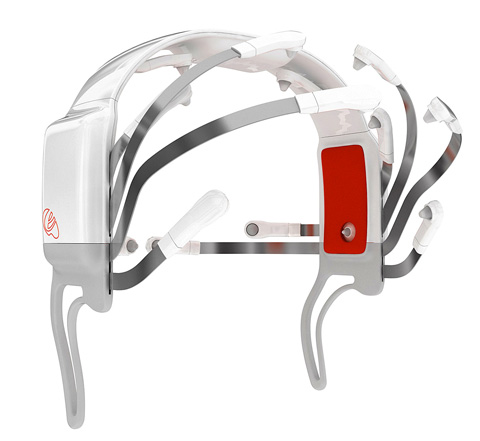It’s mind over machine: a US high-tech company has created a headset allowing computer game lovers to use their thoughts to move mountains and make objects disappear on screen.
Emotiv, a San Francisco-based startup that marries neuroscience and computer engineering, says its EPOC gaming headset offers only a glimpse of what the technology has to offer.
“There is no natural barrier from what we can see,” Emotiv co-founder Tan Le said while demonstrating the headset in the firm’s office.

PHOTO: AFP
“This is the tip of the iceberg for what is possible for us. There will be a convergence of gesture-based technology and the brain as a new interface — the Holy Grail is the mind.”
Gamers will be able to get their hands on the gadget in time for the winter holiday season, the company says.
The EPOC headset features 16 sensors that press against a user’s scalp to measure electrical activity in a brain using electroencephalography. A built-in gyro tracks head movement.

PHOTO: AFP
The sensors also register users’ moods and facial expressions, merging the data in computer software that “learns” to match readings with what people are thinking, according to Le.
“There is a direct correlation between thought and what happens on screen,” Le said. “It really fulfills this long fantasy people have had of moving objects just with thought.”
A video game will be included with the headset when the package goes on sale for US$299 at the Emotiv Web site and select shops.
The martial arts fantasy game has a rural Asian setting. An animated “master” leads players through exercises that include lifting mountains with their minds.
A test of the headset showed that after “training” the EPOC system for less than a minute one could spin, push, pull and lift objects onscreen, or make them vanish, by simply thinking about it.
“Gamers are early adopters of technology and thought control is the ultimate fantasy of gamers,” Le said.
Emotiv has a software development kit available to videogame makers as well as programmers of “anything that involves a human and a computer” including those involved in virtual worlds, cars and medical care.
The technology could be used to let virtual world characters referred to as “avatars” reflect the real-world expressions and moods of the people they represent online, according to Emotiv engineer Marco Della Torre.
The kit for third-party software savants to weave thought-control into programs has reportedly been downloaded from the Emotiv Web site more than 1,000 times.
“We have a lot of Fortune 500 companies interested,” Le said.
Even law enforcement agencies have expressed interest in the headset’s ability to read people’s minds.
“It certainly could be used as a very accurate polygraph,” Le said. “If you have seen something before, there is no hiding it. There is brain recognition.”
Medical applications could include giving stroke victims or people in comas new ways to communicate.
People wearing headsets while listening to online music could have tunes automatically tagged based on whether they made them happy, sad, excited, or bored.
Le, an Australian telecommunications entrepreneur named Young Australian of the Year in 1998, said the idea for the headset sprang from a chat about brains and technology during dinner in 2003.
Le and fellow entrepreneur Nam Do founded Emotiv with neuroscientist Allan Snyder and computer chip designer Neil Weste.

April 28 to May 4 During the Japanese colonial era, a city’s “first” high school typically served Japanese students, while Taiwanese attended the “second” high school. Only in Taichung was this reversed. That’s because when Taichung First High School opened its doors on May 1, 1915 to serve Taiwanese students who were previously barred from secondary education, it was the only high school in town. Former principal Hideo Azukisawa threatened to quit when the government in 1922 attempted to transfer the “first” designation to a new local high school for Japanese students, leading to this unusual situation. Prior to the Taichung First

The Ministry of Education last month proposed a nationwide ban on mobile devices in schools, aiming to curb concerns over student phone addiction. Under the revised regulation, which will take effect in August, teachers and schools will be required to collect mobile devices — including phones, laptops and wearables devices — for safekeeping during school hours, unless they are being used for educational purposes. For Chang Fong-ching (張鳳琴), the ban will have a positive impact. “It’s a good move,” says the professor in the department of

On April 17, Chinese Nationalist Party (KMT) Chairman Eric Chu (朱立倫) launched a bold campaign to revive and revitalize the KMT base by calling for an impromptu rally at the Taipei prosecutor’s offices to protest recent arrests of KMT recall campaigners over allegations of forgery and fraud involving signatures of dead voters. The protest had no time to apply for permits and was illegal, but that played into the sense of opposition grievance at alleged weaponization of the judiciary by the Democratic Progressive Party (DPP) to “annihilate” the opposition parties. Blamed for faltering recall campaigns and faced with a KMT chair

Article 2 of the Additional Articles of the Constitution of the Republic of China (中華民國憲法增修條文) stipulates that upon a vote of no confidence in the premier, the president can dissolve the legislature within 10 days. If the legislature is dissolved, a new legislative election must be held within 60 days, and the legislators’ terms will then be reckoned from that election. Two weeks ago Taipei Mayor Chiang Wan-an (蔣萬安) of the Chinese Nationalist Party (KMT) proposed that the legislature hold a vote of no confidence in the premier and dare the president to dissolve the legislature. The legislature is currently controlled